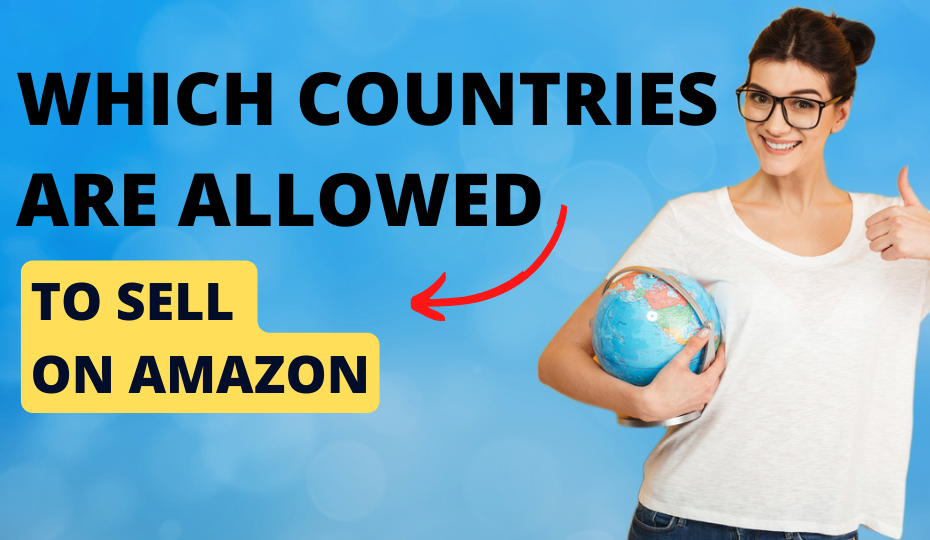· readysetfba · Account · 16 min read
What Countries is Amazon In? Unveiling the Global Footprint of E-commerce Giant
In the realm of e-commerce, Amazon stands as a titan, its influence reaching across the globe. But just how far does Amazon's global presence extend? This article aims to answer the question "What countries is Amazon in?"

In the realm of e-commerce, Amazon stands as a titan, its influence reaching across the globe. But just how far does Amazon’s global presence extend? This article aims to answer the question: “What countries is Amazon in?”
We’ll delve into the intricate web of Amazon’s international operations, exploring the breadth and depth of its worldwide services.
From its humble beginnings in a Seattle garage to its current status as a global powerhouse, Amazon’s journey is a testament to the transformative power of technology and innovation. Today, Amazon’s operations span continents, offering a diverse range of services that go beyond its original focus on book sales. From retail and digital streaming to artificial intelligence and cloud computing, Amazon’s international operations have reshaped the global e-commerce landscape.
In this comprehensive exploration, we’ll take you on a tour of Amazon’s global footprint, providing a country-by-country breakdown of its operations. We’ll delve into the history of Amazon’s global expansion, shedding light on its growth trajectory and the challenges it has overcome along the way. We’ll also examine the AmazonGlobal Shipping Program, a key component of Amazon’s worldwide services, and discuss its impact on local economies.
As we navigate the world of Amazon, we’ll also look to the future, discussing known plans for further expansion and making predictions based on current trends in e-commerce and international business. Finally, we’ll place Amazon in the broader context of the global e-commerce industry, comparing its operations with those of other e-commerce giants.
Join us as we embark on this journey, unveiling the global footprint of one of the world’s most influential companies. Whether you’re an Amazon customer, a business owner, or simply a curious reader, this exploration will provide a deeper understanding of Amazon’s global presence and its role in shaping the future of e-commerce.
Also read About Us
Amazon’s Global Reach: A Country-by-Country Breakdown
Amazon, the e-commerce giant, has a presence that spans the globe. Its operations extend far beyond its birthplace in the United States, reaching out to numerous countries worldwide. Let’s embark on a journey to understand the breadth and depth of Amazon’s international operations.
United States: Amazon’s home ground, the United States, is where it all began. With a vast network of warehouses and a massive workforce, Amazon offers a wide range of services here, including Amazon Prime, Amazon Fresh, and Amazon Music, to name a few.
Canada: Amazon’s operations in Canada are extensive, with several warehouses spread across the country. Canadians enjoy services like Amazon Prime and Amazon Music.
Mexico: Amazon has made significant inroads into Mexico, offering a broad range of products and services, including Amazon Prime.
Brazil: In Brazil, Amazon has expanded its services beyond just e-commerce, offering Amazon Prime Video and Amazon Music.
United Kingdom: The UK is one of Amazon’s largest markets outside the U.S. Amazon Prime, Amazon Fresh, and Amazon Music are popular services here.
Germany: Amazon has a strong presence in Germany, offering a wide range of services, including Amazon Prime and Amazon Fresh.
France: In France, Amazon offers a variety of services, including Amazon Prime, Amazon Music, and Amazon Fresh.
Italy: Amazon’s operations in Italy include several warehouses and a variety of services, including Amazon Prime and Amazon Fresh.
Spain: Amazon has a significant presence in Spain, offering services like Amazon Prime and Amazon Music.
Netherlands: Amazon’s operations in the Netherlands include Amazon Prime and Amazon Music.
Sweden: Amazon recently launched in Sweden, offering a wide range of products and services.
Poland: Amazon has several fulfillment centers in Poland, offering services like Amazon Prime.
India: Amazon has a significant presence in India, with numerous warehouses and a broad range of services, including Amazon Prime and Amazon Fresh.
China: Despite the competition, Amazon maintains operations in China, offering a variety of services, including Amazon Prime.
Japan: Amazon Japan offers a wide range of services, including Amazon Prime and Amazon Fresh.
Australia: Amazon has expanded its operations in Australia, offering services like Amazon Prime and Amazon Music.
United Arab Emirates: Amazon operates in the UAE, offering services like Amazon Prime.
Singapore: Amazon’s presence in Singapore includes services like Amazon Prime and Amazon Fresh.
Saudi Arabia: Amazon operates in Saudi Arabia, offering a variety of services, including Amazon Prime.
Turkey: Amazon Turkey offers a range of services, including Amazon Prime.
This comprehensive list provides a glimpse into the global reach of Amazon. However, it’s worth noting that Amazon’s presence isn’t limited to these countries. Through its AmazonGlobal shipping program, Amazon delivers products to over 100 countries worldwide, making it a truly global e-commerce giant.
| Country | Services Offered | FBA Services | Global Shipping by Amazon |
|---|---|---|---|
| United States | Amazon Prime, Amazon Fresh, Amazon Music | Yes | Yes |
| Canada | Amazon Prime, Amazon Music | Yes | Yes |
| Mexico | Amazon Prime | No | Yes |
| Brazil | Amazon Prime Video, Amazon Music | No | Yes |
| United Kingdom | Amazon Prime, Amazon Fresh, Amazon Music | Yes | Yes |
| Germany | Amazon Prime, Amazon Fresh | Yes | Yes |
| France | Amazon Prime, Amazon Music, Amazon Fresh | Yes | Yes |
| Italy | Amazon Prime, Amazon Fresh | Yes | Yes |
| Spain | Amazon Prime, Amazon Music | Yes | Yes |
| Netherlands | Amazon Prime, Amazon Music | Yes | Yes |
| Sweden | Various services | No | Yes |
| Poland | Amazon Prime | Yes | Yes |
| India | Amazon Prime, Amazon Fresh | Yes | Yes |
| China | Amazon Prime | No | Yes |
| Japan | Amazon Prime, Amazon Fresh | Yes | Yes |
| Australia | Amazon Prime, Amazon Music | No | Yes |
| United Arab Emirates | Amazon Prime | No | Yes |
| Singapore | Amazon Prime, Amazon Fresh | No | Yes |
| Saudi Arabia | Amazon Prime | No | Yes |
| Turkey | Amazon Prime | No | Yes |
Also read Which Countries Are Allowed To Sell On Amazon Usa
The Journey of Amazon: A Historical Context and Expansion Timeline
In the realm of e-commerce, Amazon stands as a towering giant, its influence reaching across the globe. But this journey to international growth wasn’t achieved overnight. The story of Amazon’s global expansion is a testament to strategic planning, relentless execution, and an unwavering commitment to customer service.
Amazon’s journey began in 1994, in the garage of Jeff Bezos in Bellevue, Washington. Initially, Amazon was a simple online bookstore, a venture that many were skeptical about. However, Bezos had a vision of a “virtual” store with millions of products, far surpassing any physical retail location. This vision was the seed that would grow into the Amazon we know today.
In 1995, Amazon.com went live, and within a month, it had shipped books to all 50 U.S. states and over 45 countries. The success of the online bookstore model was the first indication that Amazon was onto something big. The company went public in 1997, and despite not turning a profit, investors saw potential in Amazon’s business model and its ambitious plans for expansion.
The turn of the millennium saw Amazon expanding its product categories beyond books, venturing into electronics, toys, and tools. This diversification was a strategic move to position Amazon as a one-stop-shop for online shopping.
Amazon’s first international foray was in 1998 when it acquired online booksellers in the United Kingdom and Germany. This marked the beginning of Amazon’s international growth, a strategic move that would see the company establish a presence in key markets worldwide. By 2000, Amazon had launched websites in France, Japan, and Canada, further solidifying its international footprint.
The mid-2000s saw Amazon introducing services that would revolutionize online shopping. Amazon Prime, launched in 2005, offered fast, free shipping for an annual fee, a move that significantly boosted customer loyalty and sales. In 2006, Amazon Web Services (AWS) was launched, marking Amazon’s entry into cloud computing.
Amazon’s global expansion continued in the following years, with marketplaces opening in Italy (2010), Spain (2011), India (2013), Mexico (2015), Australia (2017), and the Middle East (2019). Each expansion came with its unique challenges, from navigating different regulatory environments to adapting to local shopping habits. However, Amazon’s commitment to customer service and its ability to adapt quickly to new markets ensured its success.
Today, Amazon operates in over 20 countries, with dedicated websites for each. Its global reach is further extended by the AmazonGlobal shipping program, which ships products to over 100 countries worldwide.
The journey of Amazon’s global expansion is a story of vision, innovation, and resilience. From a simple online bookstore to a global e-commerce giant, Amazon’s history is a testament to the power of thinking big and disrupting traditional business models. As we look to the future, there’s no doubt that Amazon’s international growth will continue to shape the landscape of global e-commerce.
Also read Where Does Helium 10 Get Its Data
Understanding the AmazonGlobal Shipping Program
Amazon’s global reach extends beyond the countries where it has physical operations. Through the AmazonGlobal Shipping Program, the company serves customers in over 100 countries worldwide, making it a truly global e-commerce giant. This program is a testament to Amazon’s commitment to making its vast product range accessible to customers around the globe.
The AmazonGlobal Shipping Program works by allowing customers from around the world to order products from Amazon’s websites. When a customer places an order, Amazon handles the international shipping and customs clearance, delivering the product right to the customer’s doorstep. This seamless process makes it easy for customers to shop on Amazon, regardless of their location.
The program serves a wide range of countries, from populous nations like India and China to smaller countries like Malta and Cyprus. However, it’s important to note that not all products are available for international shipping due to various restrictions and regulations. For instance, certain electronics, hazardous materials, and oversized items may not be eligible for international shipping.
The types of products that can be shipped internationally vary by country and are subject to local laws and regulations. For example, while books, clothing, and most electronics can be shipped to almost any country, other items like certain dietary supplements and beauty products may have more restrictions. Customers can check the product’s detail page to see if the item can be shipped to their location.
Shipping rates and fees are also a crucial aspect of the AmazonGlobal Shipping Program. These fees are calculated based on a number of factors, including the shipping speed, the weight and size of the item, and the destination country. Amazon provides an estimated customs duty and tax during checkout, so customers are aware of the total cost before placing their order.
Despite its many benefits, the AmazonGlobal Shipping Program does have some limitations. For instance, Amazon cannot deliver certain items internationally due to local import restrictions. Additionally, some countries have strict customs regulations that can delay the delivery of items.
In conclusion, the AmazonGlobal Shipping Program is a significant part of Amazon’s international operations, enabling the company to serve customers in countries where it does not have a physical presence. By understanding how this program works, what countries it serves, what types of products can be shipped internationally, and any restrictions or limitations, we can gain a deeper insight into Amazon’s global footprint.
Also read Amazon Fba Warehouse Locations
The Impact of Amazon on Local Economies
Amazon’s operations have a significant impact on the local economies of the countries where it operates. This influence can be seen in various aspects, from job creation and infrastructure development to competition with local businesses and changes in consumer behavior.
Positive Impacts
One of the most apparent positive impacts of Amazon’s presence in a country is job creation. Amazon employs hundreds of thousands of people worldwide, from warehouse workers and delivery drivers to software engineers and corporate executives. In the United States alone, Amazon is one of the largest employers, with over 800,000 employees. This job creation extends to the countries where Amazon has fulfillment centers, warehouses, and offices, contributing to the local economy and reducing unemployment rates.
Amazon’s operations also lead to infrastructure development. The construction of warehouses and fulfillment centers often necessitates the improvement of local roads, utilities, and other infrastructure, which can benefit the broader community. Moreover, Amazon’s demand for delivery services can stimulate the growth of local logistics and transportation industries.
Negative Impacts
Despite these positive impacts, Amazon’s presence also has some negative effects on local economies, primarily due to its competition with local businesses. Amazon’s vast selection, low prices, and convenience can draw customers away from local retailers, particularly small and medium-sized businesses. This competition can lead to business closures and job losses in the retail sector, which can have a ripple effect on the local economy.
Furthermore, Amazon’s dominance in the e-commerce market can stifle innovation and entrepreneurship. Potential entrepreneurs may be discouraged from starting new businesses due to the difficulty of competing with Amazon. This can limit the diversity and resilience of the local economy.
Balancing the Scales
Understanding the economic impact of Amazon on local economies is a complex task, as it involves weighing these positive and negative effects. On the one hand, Amazon creates jobs and stimulates infrastructure development. On the other hand, it competes with local businesses and can limit economic diversity.
In the end, the impact of Amazon on a local economy depends on various factors, including the country’s economic structure, the strength of its retail sector, and its policies towards multinational corporations. As Amazon continues to expand its global footprint, understanding these impacts will be crucial for policymakers, businesses, and consumers alike.
Also read Common Terms Amazon
Looking Ahead: Amazon’s Future Plans and Predictions
As we delve into the future of Amazon’s global expansion, it’s important to note that the company’s plans are often kept under wraps until the right moment. However, through careful analysis of their business strategies, market trends, and recent developments, we can make some educated predictions about where Amazon might set its sights next.
Amazon’s future plans are likely to be influenced by a combination of factors, including emerging markets, technological advancements, and changing consumer behaviors. One area of potential expansion is Africa, a continent where e-commerce is still in its infancy but is rapidly growing. Countries like Nigeria, South Africa, and Kenya have burgeoning tech scenes and represent untapped markets for Amazon. The company has already made a foray into the African market with AWS (Amazon Web Services) launching in South Africa in 2020. However, the retail side of Amazon is yet to make a significant impact.
In terms of e-commerce trends, the rise of mobile shopping is one that Amazon is sure to capitalize on. With increasing smartphone penetration in developing countries, Amazon may focus on improving its mobile platform and services in these regions. This could involve developing apps or features tailored to these markets, such as data-light versions of the Amazon app or payment options that cater to the local financial infrastructure.
Another trend that could shape Amazon’s future plans is the growing consumer demand for sustainable and ethical products. As consumers become more conscious of their environmental impact, Amazon may look to expand its range of eco-friendly products or introduce new sustainability initiatives. This could also extend to their operations, with potential for more sustainable packaging and delivery methods.
Artificial intelligence (AI) and machine learning are also set to play a significant role in the future of e-commerce. Amazon has been a pioneer in this field, with features like product recommendations, Alexa, and anticipatory shipping all powered by AI. As these technologies continue to evolve, we can expect Amazon to remain at the forefront, potentially expanding these services into new markets.
Lastly, Amazon’s potential new markets are not limited to geographical locations. The company has shown a propensity for diversification, venturing into industries like entertainment with Amazon Prime Video, and healthcare with Amazon Pharmacy. It’s plausible that Amazon could continue to expand its services into new sectors. Potential areas could include education technology, financial services, or even travel and tourism.
Also read Amazon Fba Box Size Limits
Amazon vs. The World: Comparisons with Other E-commerce Giants
In the realm of e-commerce, Amazon stands as a titan, but it’s not alone in its global reach. Other e-commerce giants, notably Alibaba and eBay, also have a significant international presence. Understanding the global footprint of these companies alongside Amazon provides a broader context for grasping the scale and impact of online retail.
Amazon vs. Alibaba
Amazon and Alibaba, the Chinese e-commerce behemoth, are often compared due to their similar business models and vast influence. However, their global presence differs significantly. While Amazon has established operations in around 20 countries with dedicated websites, Alibaba’s primary market remains China. It has, however, made strides in reaching international customers through AliExpress, its global retail marketplace.
In terms of product offerings, both companies provide a wide range of goods, from electronics to fashion. However, Alibaba’s marketplace model, which connects buyers directly with manufacturers, often results in lower prices, making it a popular choice for bulk purchases and business-to-business transactions. On the other hand, Amazon’s emphasis on customer service, fast shipping, and a vast selection of products, particularly through its Prime service, has earned it a loyal customer base worldwide.
Amazon vs. eBay
eBay, another major player in the e-commerce space, operates a different model from Amazon. While Amazon sells products directly and also allows third-party sellers on its platform, eBay primarily serves as a marketplace for third-party sellers, with auctions being a significant part of its business model.
eBay operates in more than 30 countries, but its presence is less about physical operations and more about online reach. Unlike Amazon, which has warehouses and distribution centers worldwide, eBay relies on its sellers for product storage and shipping. This model allows eBay to have a broad international reach without the need for substantial physical infrastructure.
In terms of customer experience, eBay’s auction model offers a unique shopping experience that can result in lower prices for patient and savvy bidders. Amazon, however, with its vast inventory and quick shipping, particularly for Prime members, often delivers a more consistent and convenient shopping experience.
In conclusion, while Amazon’s global presence is impressive, it’s not the only e-commerce giant with a significant international footprint. Both Alibaba and eBay offer different business models, product offerings, and customer experiences, making the global e-commerce landscape diverse and competitive. As these companies continue to evolve and expand, it will be fascinating to see how the balance of power shifts in the world of online retail.
Also read Amazon Fba Pallet Requirements
Conclusion
In this comprehensive exploration, we’ve delved deep into the global presence of Amazon, one of the world’s leading e-commerce giants. We’ve journeyed through the vast expanse of countries where Amazon has firmly planted its operations, offering a myriad of services tailored to each region’s unique needs and demands.
From the bustling marketplaces of the United States and the United Kingdom to the emerging economies of India and Brazil, Amazon’s international operations have left an indelible mark on the global e-commerce landscape.
We’ve also examined the intricate workings of the AmazonGlobal Shipping Program, a testament to Amazon’s commitment to reaching customers far and wide.
We’ve also delved into the profound impact Amazon has had on local economies, both positive and negative, and explored the company’s future plans and predictions in the realm of global expansion.
Finally, we’ve compared Amazon’s global presence with other e-commerce giants, offering a broader context for understanding its operations.
In essence, the question of “what countries is Amazon in” reveals a story of relentless expansion, adaptation, and innovation.
It’s a story that continues to unfold, shaping the future of e-commerce on a global scale.



